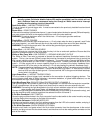
Connect the green wire to the master switch side of the cut wire.
Cut the existing unlock wire, and connect the white wire to the slave switch or motor side of the cut wire.
Connect the blue wire to the master switch side of the cut wire.
The orange and blue w/ white stripe wires must be connected to a fused + 12 VDC battery source.
Refer to the door lock wiring supplement for proper connection of these wires into the various locking
circuits available in current vehicles.
6 Pin Door Lock Output Connector :
When wiring for 2 step unlock operation, you must connect the outputs of the on board unlock relay to the
driver’s door lock motor. Wire these outputs as follows;
Orange = N.O. Relay Contact to + 12 VDC Battery
Dark Blue = N.C. Relay Contact to Motor leg switch side
White = Common Relay Contact to Motor leg motor side
Wire the transistorized negative “all doors unlock“ output directly to the negative unlock wire from the door
lock switch in vehicles with 3 wire ground switched circuits.
In vehicles with 3 wire positive or 5 wire alternating switched circuits, you must add a 30 Amp automotive
relay to provide the “all doors unlock“ feature.
Red w/ Black & Green w/ Black 2 Pin Red Connector : 2 Step Unlock Connector
The green w/ black tracer wire provides a 300 mA ground pulse output for the all doors unlock signal, and
can be connected to the negative door unlock wire in 3 wire negative switched vehicles.
The red w/ black trace wire provides a low current (300mA) + 12 VDC source for those applications that
require a relay for the all doors unlock feature. This wire should be connected to the relay coil only. A
separate +12 VDC source must be used for the high current relay contacts.
Resistive Circuits, As Well As 4 Wire Polarity Reversal and 5 Wire Alternating 12 Volt
Door Lock Control Circuits
These applications require the use of additional components which may include relays, fixed resistors, or
for convenience, the AS 9159 Door Lock Interface. Refer to the AUDIOVOX Door Lock Wiring
Supplement and or the Audiovox fax back service for information on your particular vehicle for properly
connecting to these types of circuits.
COMPLETING THE INSTALLATION
Antenna Wire : Be sure to extend the thin black antenna wire to it’s full length, and cable tie into place
where it cannot be damaged. Avoid wrapping this wire around major, high current wire looms.
Adjusting the Shock Sensor : If used, the sensitivity of the pre - detect circuit is automatically set 30%
less sensitive than the full trigger circuit.
Using a small screwdriver, gently turn the adjustment screw fully counterclockwise. (DO NOT over turn
this screw. Maximum rotation for this adjustment is 270°). Close the hood and trunk lids, and arm the
alarm. Wait 6 seconds for the accessories trigger zone to stabilize, then firmly strike the rear bumper with
the side of a closed fist considering the amount of force required to break a window.
CAUTION : Never perform this test on the vehicle’s glass, as you may break the window.
Turn the adjustment screw clockwise (increasing sensitivity) about ¼ turn and re-test. Repeat this procedure
until the alarm sounds. Ultimately, one firm strike to the rear bumper will cause the alarm to emit pre-detect
warning tones.
WARNING ! Setting the sensitivity too high can cause false alarms due to noise vibrations from
passing trucks and heavy equipment. To decrease sensitivity, turn the adjustment screw
counter clockwise.
Wire Dressing: Always wrap the alarm wires in convoluted tubing, or with a spiral wrap of electrical tape.
Secure these looms along the routing using cable ties. This will ensure that the alarm wires are not
damaged by falling onto hot or sharp moving surfaces in the vehicle.
Operation: Take a few moments to check off the appropriate option boxes in the owner’s manual, and to
fully explain the operation of the system to your customer.










